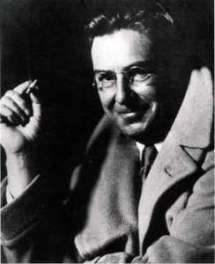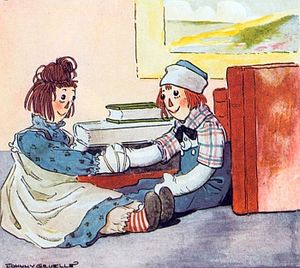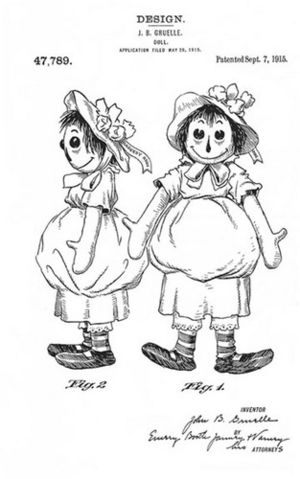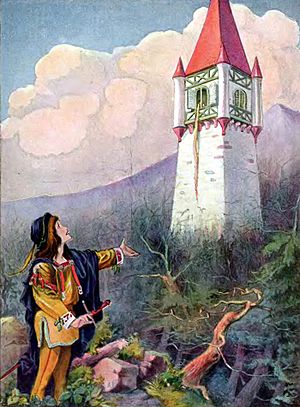Johnny Gruelle facts for kids
Quick facts for kids
Johnny Gruelle
|
|
|---|---|

Johnny Gruelle
|
|
| Born | John Barton Gruelle December 24, 1880 Arcola, Illinois, U.S. |
| Died | January 9, 1938 (aged 57) Miami Springs, Florida, U.S. |
| Occupation | Artist, writer |
| Genre | Children's literature, comic strip |
| Notable works | Raggedy Ann Stories (1918), The Magical Land of Noom (1922), and other books; Raggedy Ann and Raggedy Andy characters |
John Barton Gruelle (born December 24, 1880 – died January 9, 1938) was an American artist, cartoonist, children's book author, and storyteller. He is most famous for creating the Raggedy Ann and Raggedy Andy dolls. He also wrote and illustrated many books. Gruelle drew cartoons and pictures for many newspapers and magazines. His father, Richard Gruelle, was a well-known painter.
Contents
Early life and family
Johnny Gruelle was born in Arcola, Illinois, on December 24, 1880. When he was two years old, his family moved to Indianapolis, Indiana. They lived there for over 25 years.
Johnny grew up surrounded by art and books. His father, Richard, was a painter who taught himself. He was part of a group of artists called the Hoosier Group. A family friend was the poet James Whitcomb Riley. Riley's poems, "Little Orphant Annie" and "The Raggedy Man," later inspired the name for Johnny Gruelle's famous character, Raggedy Ann. Johnny later wrote a book called The Orphant Annie Story Book (1921) to honor Riley.
Johnny was the oldest of three children. His parents made sure all their children learned about music, books, and art. Johnny loved art and learned to draw from his father. His sister, Prudence, became a children's author and newspaper writer. His brother, Justin, became a painter and illustrator.
Marriage and family life
Johnny Gruelle married Myrtle J. Swann in Indianapolis on March 23, 1901. Their first child, Marcella, was born in 1902. Sadly, Marcella died at age 13 in 1915. The Gruelles also had two sons, Worth and Richard. Worth later became an artist like his father.
Johnny and Myrtle first lived in Indianapolis, then moved to Cleveland, Ohio. By 1910, they moved to Silvermine, Connecticut. This area was an art colony where Johnny's parents and other family members also lived. The Gruelles built a home there. After Marcella's death, they moved to Norwalk, Connecticut. Living on the East Coast gave Johnny more chances to work as an artist for newspapers and magazines.
Johnny also spent a year in Ashland, Oregon, from 1923 to 1924.
Johnny's career
Johnny Gruelle started his career drawing for newspapers in Indianapolis. His drawings soon appeared in newspapers all over the country. He also drew pictures for famous fairy tales. He wrote and illustrated his own stories too.
Gruelle is most famous for creating the Raggedy Ann doll and the stories about her and her friends. He also made the Raggedy Ann and Raggedy Andy dolls. Besides being a successful artist and writer, Johnny loved nature and telling stories.
Early work
In his early career, Gruelle drew cartoons about politics and sports for Indianapolis newspapers. By 1903, he worked for the Indianapolis Star. His cartoons of a crow wearing a top hat appeared on the front page. This crow became the Star's weather bird and was featured for many years. (The bird was first called "Jim Crow" but was renamed "Joe Crow" in the 1950s.)
From 1906 to 1911, his cartoons appeared in other city newspapers. His big break came in 1910–1911. He won first and second place in a comic-drawing contest held by the New York Herald. His winning cartoon, "Mr. Twee Deedle," was published weekly across the country until 1918.
As Gruelle became known for his cartoons, he also started writing and illustrating fairy tales. His first big job was drawing pictures for a book of Grimms' Fairy Tales (1914). He also illustrated and retold other fairy tales like "Cinderella," "Little Red Riding Hood," and "Hansel and Gretel." He wrote his own book, My Very Own Fairy Stories (1917). In his stories, Gruelle often taught good lessons, which became a special part of his work. In 1917, he also created a cartoon series called Quacky Doodles.
Creating Raggedy Ann
The exact story of how Raggedy Ann came to be is a bit unclear. A popular story says that Johnny's daughter, Marcella, found an old rag doll in her grandmother's attic. Johnny then drew a face on it. Another story, told by Johnny's wife, Myrtle, is that Johnny found an old rag doll his mother had made. He thought it would make a good story. He remembered the doll when he saw Marcella playing with dolls and got ideas from watching her.
Some people also say that Johnny started writing the Raggedy Ann stories when his daughter Marcella was very sick. They believe her death at age 13 inspired him to publish the stories and create the doll to remember her.
What we do know for sure is that Johnny Gruelle applied for a patent for the design of the Raggedy Ann doll on May 28, 1915. He received approval for the patent (U.S. Patent D47,789) on September 7, 1915, around the time Marcella became ill. On June 17, 1915, he applied for a trademark for the name Raggedy Ann. He got the name from two poems by James Whitcomb Riley: "The Raggedy Man" and "Little Orphant Annie."
The P. F. Volland Company published Gruelle's Raggedy Ann Stories in 1918. This was the first book about his Raggedy Ann rag-doll character. Both the book and the doll became very popular.
At first, Gruelle's family might have made the first Raggedy Ann dolls to help sell the books. But soon, Gruelle made a deal with his publisher, P. F. Volland Company, to mass-produce the dolls. Two years later, Gruelle introduced Raggedy Ann's brother, Raggedy Andy, in Raggedy Andy Stories (1920). Gruelle also patented his design for a boy doll (U.S. Patent D56,149). Soon after, Raggedy Andy dolls were also made.
Other creative works
Besides the Raggedy Ann books, Gruelle wrote and illustrated other children's books. These included Friendly Stories (1919) and The Magical Land of Noom (1922). He also wrote The Orphant Annie Story Book (1921) and Johnny Mouse and the Wishing Stick (1922). The success of his early books made him a famous children's author. He continued to work on newspaper and magazine projects while writing at least one Raggedy Ann and Raggedy Andy story every year.
In 1929, the New York Herald Tribune Syndicate started a comic strip called "Brutus." Gruelle worked on this comic strip until he died in 1938.
Gruelle also wrote songs for children. His lyrics for "Raggedy Ann's Sunny Songs" (1930) were set to music by William H. Woodin, who used to be a U.S. Treasury Secretary.
Later years and legacy
In 1932, Gruelle and his wife moved from Connecticut to Miami, Florida. In his later years, Gruelle kept writing and illustrating books like Raggedy Ann and the Golden Meadow (1935). His son, Worth, helped him with this book. They also worked together on a series of Raggedy Ann proverbs that appeared in newspapers. Gruelle also drew funny cartoons and made public appearances. He enjoyed collecting cars as a hobby.
Even though the Great Depression in the 1930s caused some problems, like his main publisher going bankrupt, Gruelle continued his work. He died suddenly from heart failure on January 9, 1938, at his son Worth's home in Miami Springs, Florida. He was 57 years old. He is buried in Silvermine Cemetery in New Canaan, Fairfield County, Connecticut. After his death, his wife, Myrtle, worked to protect the rights to his books and characters.
During his 40-year career, Gruelle wrote or illustrated many books. He also contributed to many newspapers and magazines. But he is best known for creating the Raggedy Ann doll and her stories. By the time he died, his first Raggedy Ann book had sold over 3 million copies! The Raggedy Ann and Raggedy Andy dolls he designed are now popular collector's items.
Gruelle's stories often taught lessons about "sharing, compassion, and telling the truth." His illustrations were colorful and dreamlike. Animation historian Donald Crafton said Gruelle's drawings looked like the early Disney cartoons of the 1930s.
Other famous cartoonists like Dr. Seuss have said that Gruelle inspired their work. Johnny Gruelle's creative work lives on through new Raggedy Ann and Raggedy Andy dolls, many reprints of his books, and new cartoons and movies based on his characters.
Honors and tributes
- Gruelle's Raggedy Ann doll was added to the National Toy Hall of Fame in Rochester, New York, in 2002. Raggedy Andy was added in 2007.
- A radio story called "Raggedy Ann in Ashland" was part of a series about the year Gruelle spent in Ashland, Oregon, from 1923–24.
Selected published works
Johnny Gruelle wrote and illustrated many books, especially about Raggedy Ann and Andy. Some of his most famous works include:
- Mr. Twee Deedle (1913)
- My Very Own Fairy Stories (1917)
- Raggedy Ann Stories (1918)
- Raggedy Andy Stories (1920)
- The Magical Land of Noom (1922)
- Raggedy Ann and Andy and the Camel with the Wrinkled Knees (1924)
- Marcella: A Raggedy Ann Story (1929)
- Raggedy Ann's Sunny Songs (1930)
- Raggedy Ann in the Golden Meadow (1935)
He also illustrated books written by others, such as:
- Grimms' Fairy Tales (1914)
- All About Cinderella (1916)
- All About Little Red Riding Hood (1916)
- All About Hansel and Grethel (1917)
Images for kids
See also
 In Spanish: Johnny Gruelle para niños
In Spanish: Johnny Gruelle para niños





